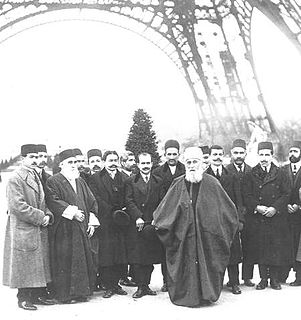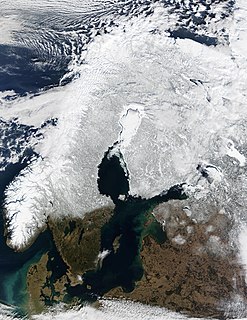The following is a basic timeline of the Bábí and Bahá'í religions emphasizing dates that are relatively well known. For a more comprehensive chronology of the timeline, see the references at the bottom.
Spiritual Assembly is a term given by `Abdu'l-Bahá to refer to elected councils that govern the Bahá'í Faith. Because the Bahá'í Faith has no clergy, they carry out the affairs of the community. In addition to existing at the local level, there are national Spiritual Assemblies.
The Bahá'í Faith has had challenges to its leadership, usually at the death of the head of the religion. The vast majority of Bahá'ís have followed a line of authority from Bahá'u'lláh to `Abdu'l-Bahá to Shoghi Effendi to the Custodians to the Universal House of Justice. Sects diverging from this line of leadership have failed to attract a sizeable following. In this sense, there is only one major branch of the Bahá'í Faith, represented by at least 5 million adherents, whereas the groups that have broken away have either become extinct with time, or have remained very small in number, representing far less than 0.1% of all Bahá'ís. Globally the Bahá'í community has maintained its unity.
The Bahá'í Faith in the United Kingdom started in 1898 when Mrs. Mary Thornburgh-Cropper, an American by birth, become the first Bahá'í in England. Through the 1930s, the number of Bahá'ís in the United Kingdom grew, leading to a pioneer movement beginning after the Second World War with sixty percent of the British Bahá'í community eventually relocating. At the 2011 UK Census, there were 5,021 Bahá'ís in England and Wales.
The Bahá'í Faith in Norway began with contact between traveling Scandinavians with early Persian believers of the Bahá'í Faith in the mid-to-late 19th century. Bahá'ís first visited Scandinavia in the 1920s following `Abdu'l-Bahá's, then head of the religion, request outlining Norway among the countries Bahá'ís should pioneer to and the first Bahá'í to settle in Norway was Johanna Schubartt. Following a period of more Bahá'í pioneers coming to the country, Bahá'í Local Spiritual Assemblies spread across Norway while the national community eventually formed a Bahá'í National Spiritual Assembly in 1962. In 2010 the national census reported around 1000 Bahá'ís in the country however the Association of Religion Data Archives estimated some 2700 Bahá'ís in 2005.

Though mentioned in the Bahá'í literature in the 19th century, the Bahá'í Faith in Germany begins in the early 20th century when two emigrants to the United States returned on prolonged visits to Germany bringing their newfound religion. The first Bahá'í Local Spiritual Assembly was established following the conversion of enough individuals to elect one in 1908. After the visit of `Abdu'l-Bahá, then head of the religion, and the establishing of many further assemblies across Germany despite the difficulties of World War I, elections were called for the first Bahá'í National Spiritual Assembly in 1923. Banned for a time by the National Socialist government and then in East Germany the religion re-organized and was soon given the task of building the first Bahá'í House of Worship for Europe. After German reunification the community multiplied its interests across a wide range of concerns earning the praise of German politicians. German Census data shows 5600 registered Bahá'ís in Germany in 2012. But there might be much more who are not enrolled in the official community. The Association of Religion Data Archives estimated some 11743 Bahá'ís in 2005.
The Bahá'í Faith in Bosnia and Herzegovina begins with mention by `Abdu'l-Bahá, then head of the religion, of Austria-Hungary which Bosnia and Herzegovina were part of at the time. Between the World Wars when Bosnia and Herzegovina were part of Yugoslavia, several members of Yugoslavian royalty had contact with prominent members of the religion. During the period of Communism in Yugoslavia, the first member of the Bahá'í Faith was in 1963 and the first Bahá'í Local Spiritual Assembly was formed in 1990. With the Yugoslavian civil war and separation into Bosnia and Herzegovina, the Bahá'ís had not elected a Bahá'í National Spiritual Assembly but do have a small population in a few regions in the country.
The Bahá'í Faith in Dominica begins with a mention by `Abdu'l-Bahá, then head of the religion, in 1916 as Latin America being among the places Bahá'ís should take the religion to. The island of Dominica was specifically listed as an objective for plans on spreading the religion in 1939 by Shoghi Effendi, who succeeded `Abdu'l-Baha as head of the religion. In 1983, William Nedden is credited with being the first pioneer to Dominica at the festivities associated with the inaugural election of the Dominican Bahá'ís National Spiritual Assembly with Hand of the Cause, Dhikru'llah Khadem representing the Universal House of Justice. Later research records Ivor Ellard arrived two days before, April 17, 1966. The first Bahá'í Local Spiritual Assembly of Dominica was elected in 1976. Since then, Bahá'ís have participated in several projects for the benefit of the wider community, and in 2001 various sources report between less than 1.4% and up to 1.7% of the island's approximately 70,000 citizens are Bahá'ís.
The Bahá'í Faith in Sweden began after coverage in the 19th century followed by several Swede-Americans who had met 'Abdu'l-Bahá in the United States around 1912 and pioneered or visited the country starting in 1920. By 1932 translations of Bahá'í literature had been accomplished and around 1947 the first Bahá'í Local Spiritual Assembly had been elected in Stockholm. In 1962 the first National Spiritual Assembly of Sweden was elected. The Bahá'ís claim about 1,000 members and 25 local assemblies in Sweden.
The Bahá'í Faith in Rwanda begins after 1916 with a mention by `Abdu'l-Bahá, then head of the religion, that Bahá'ís should take the religion to the regions of Africa. The first specific mention of Rwanda was in May 1953 suggesting the expanding community of the Bahá'í Faith in Uganda look at sending pioneers to neighboring areas like Ruanda. The first settlers of the religion arrived in the region by July 1953 when Bahá'ís from the United States and Malawi arrived. By 1963 there were three Bahá'í Local Spiritual Assemblies in Burundi-Ruanda. Through succeeding organizations of the countries in the region, the National Spiritual Assembly of Rwanda was formed in 1972. Bahá'ís, perhaps in the thousands, were among those who perished in the Rwandan Genocide Following the disruption of the Rwandan Civil War the national assembly was reformed in 1997. The Bahá'ís of Rwanda have continued to strive for inter-racial harmony, a teaching which Denyse Umutoni, an assistant director of Shake Hands with the Devil, mentions as among the reasons for her conversion to the religion. 2001 estimates place the Bahá'í population around 15000 while 2005 estimates from the same source shows just over 18900.
The Bahá'í Faith is a diverse and widespread religion founded by Bahá'u'lláh in the 19th century in Iran. Bahá'í sources usually estimate the worldwide Bahá'í population to be above 5 million. Most encyclopedias and similar sources estimate between 5 and 6 million Bahá'ís in the world in the early 21st century.
The Bahá'í Faith in Angola begins after `Abdu'l-Bahá wrote letters encouraging taking the religion to Africa in 1916. The first Bahá'í pioneered to Angola about 1952. By 1963 there was a Bahá'í Local Spiritual Assembly in Luanda and smaller groups of Bahá'ís in other cities. In 1992 the Bahá'ís of Angola elected their first National Spiritual Assembly. The Association of Religion Data Archives estimated some 2,000 Bahá'ís in 2005.
While the first mention of events related to the history of the Bahá'í Faith in New Zealand was in 1846 continuous contact began around 1904 when one individual after another came in contact with Bahá'ís and some of them published articles in print media in New Zealand as early as 1908. The first Bahá'í in the Antipodes was Dorothea Spinney who had just arrived from New York in Auckland in 1912. Shortly thereafter there were two converts about 1913 - Robert Felkin who had met `Abdu'l-Bahá in London in 1911 and moved to New Zealand in 1912 and is considered a Bahá'í by 1914 and Margaret Stevenson who first heard of the religion in 1911 and by her own testimony was a Bahá'í in 1913. After `Abdu'l-Bahá wrote the Tablets of the Divine Plan which mentions New Zealand the community grew quickly so that the first Bahá'í Local Spiritual Assembly of the country was attempted in 1923 or 1924 and then succeeded in 1926. The Bahá'ís of New Zealand elected their first independent National Spiritual Assembly in 1957. By 1963 there were four Assemblies, and 18 localities with smaller groups of Bahá'ís. The 2006 census reports about 2800 Bahá'ís in some 45 local assemblies and about 20 smaller groups of Bahá'ís though the Association of Religion Data Archives estimated there were some 7400 Bahá'ís in 2005.
The Bahá'í Faith in Portugal comes after the first mention of Portugal in Bahá'í literature when `Abdu'l-Bahá mentioned it as a place to take the religion to in 1916. The first Bahá'í visitor to Portugal was in 1926. Its first Bahá'í Local Spiritual Assembly was elected in Lisbon in 1946. In 1962 the Portuguese Bahá'ís elected their first National Spiritual Assembly. In 1963 there were nine assemblies. According to recent counts there are close to some 2000 members of the Bahá'í Faith in 2005 according to the Association of Religion Data Archives.
The Bahá'í Faith in Andorra begins with the first mention of Andorra in Bahá'í literature when `Abdu'l-Bahá listed it as a place to take the religion to in 1916. The first Bahá'í to pioneer to Andorra was William Danjon Dieudonne in 1953. By 1979 a Bahá'í Local Spiritual Assembly in Andorra-la-Vella is known. In 2005 according to the Association of Religion Data Archives there were about 80 Bahá'ís in Andorra. In 2010 Wolfram Alpha estimated about 120 Bahá'ís.
The Bahá'í Faith in Hungary started in various mentions of the religion in the 19th century followed by `Abdu'l-Bahá's trip to Hungary in 1913 when Hungary's first Bahá'í joined the religion. The community suffered from World War II and communist rule until the 1980s. The National Assembly was elected in 1992 and growth since then places 2002 estimates by Bahá'ís at between 1100 and 1200 Bahá’is in Hungary, many are Roma. However, according to the 2005 Association of Religion Data Archives data there are close to some 290.

The Bahá'í Faith is a diverse and widespread religion founded by Bahá'u'lláh in the 19th century in Iran. Bahá'í sources usually estimate the worldwide Bahá'í population to be above 5 million. Most encyclopedias and similar sources estimate between 5 and 6 million Bahá'ís in the world in the early 21st century. The religion is almost entirely contained in a single, organized, hierarchical community, but the Bahá'í population is spread out into almost every country and ethnicity in the world, being recognized as the second-most geographically widespread religion after Christianity. See Bahá'í statistics.
The Bahá'í Faith in Burundi begins after 1916 with a mention by `Abdu'l-Bahá, then head of the religion, that Bahá'ís should take the religion to the regions of Africa. The first specific mention of Burundi (Urundi) was in May 1953 suggesting the expanding community of the Bahá'í Faith in Uganda look at sending pioneers to neighboring areas like Burundi(Urundi) as part of a specific plan of action. The first settlers of the religion arrived in the region by June. By 1963 there were three Bahá'í Local Spiritual Assemblies in Burundi-Ruanda. Through succeeding organizations of the countries in the region, the National Spiritual Assembly of Burundi was first formed in 1969 but was successively dissolved and reformed a number of times - most recently reforming in 2011. Even though the religion was banned for a time, and the country torn by wars, the religion grew so that in 2005 the Association of Religion Data Archives estimated just about 6,800 Bahá'ís in Burundi.















